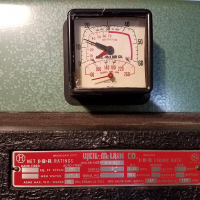Welcome! Here are the website rules, as well as some tips for using this forum.
Need to contact us? Visit https://heatinghelp.com/contact-us/.
Click here to Find a Contractor in your area.
Too much air for combustion
Options
Rizz861
Member Posts: 52
in Gas Heating
I’ve noticed a lot of boilers (non high efficiency) without a solid chassis on the bottom getting installed on blocks. So they now have an additional spot besides the louvre on the chassis to draw air in for combustion. The flame is always very yellow even with a clean boiler and proper gas pressure. Now I was told these are to sit flat on the floor or a cement pad to prevent extra air from getting drawn into the bottom of the boiler. I looked at a random Burnham manual and it is not so straight forward. It says to sit boiler on floor (solid is implied) or to put on a raised solid base (ie a cement pad which has no breaks). They seem to imply that it wants to sit on a continuously solid base but fail to say what adverse effects can happen by putting it on blocks. A combustion test verifies blocks aren’t the way to go because the excess air and 02 level are always sky high. And FYI, I’m getting this info about boiler placement and excess air from Timmie (I took his class in RI and he is the one who made me start seeing this). I’d like to find a boiler manual or hear from some other guys that say what I’m saying so I can show my boss. I know we could go the cement pad approach, or blocks with a piece of sheet metal closing the bottom to prevent excess air approach. Thanks in advance guys
0
Comments
-
Blocks are cheap. We simply put ours up on enough blocks to mimic the floor. Problem solved.All Steamed Up, Inc.
Towson, MD, USA
Steam, Vapor & Hot-Water Heating Specialists
Oil & Gas Burner Service
Consulting2 -
-
So plugging two gas jets on an atmospheric would not affect the free air?
2 chambers not burning....no combustion.0 -
Hmm...
For safety we use blocks to raise the boiler 18" off of the floor in a Garage area as per manufacturers instructions,Local code and industry standards..
On Combustible surfaces we use ether a metal platform suppied by the manufacturer or standard 8"X2"X16"cement blocks and a piece of Sheetmetal from the local home center...
At plus10.000 feet elevation none of these "Platforms" will result in a change of Combustion air.. Just may keep dust bunnies out of the equation.
BTW: Yellow flames do not necessarily indicate maladjusted combustion.
0 -
Yes, I realize that.
I have often wondered about the open bottom with corner blocks only.
IMO, it seems the air is drawn up by the burning gases creating a gravity chimney effect.
And with the "floor" being 4-8" below the burners than original design there would be less resistance to air travel up the flue.
There has been discussion about plugging gas jets to downfire boilers, comments were that it would affect the excess air (possibly other things) if not all the jets were firing.
But if what you say is true then the fire would only use as much free air as needed?
0 -
I’m not a fan of down firing. The boiler furnace was designed and tested under certain conditions. I doubt the manufacturer tested with burners plugged.0
-
There were some older boilers that came from the factory with one burner jet capped.
Same block as next size up, I believe that was their method of down firing/sizing.
But that was then.
Today, I would bet they design and test boilers sitting on a solid base, not corner blocks.
And some brands have a solid base sheet metal pan, would they include that if they thought it unnecessary?0 -
If it made a difference yes I think they would.JUGHNE said:There were some older boilers that came from the factory with one burner jet capped. Same block as next size up, I believe that was their method of down firing/sizing. But that was then. Today, I would bet they design and test boilers sitting on a solid base, not corner blocks. And some brands have a solid base sheet metal pan, would they include that if they thought it unnecessary?Fire only need X amount of oxygen for combustion. If you force more ox in you in theory extinguish the flame by upsetting the triangle!0 -
It seems that pulling air from under the burners, in addition from the front, would provide excess O2.
Above my pay grade, we need input from Tim.0 -
Keep in mind “Air” is 78% N2 and 21% oxygen!0
-
Really !!0
-
@JUGHNE You are correct on what you said. I took Tim’s class in Rhode Island and what I’m talking about is something I’d learned from him. Having that opening definitely throws everything off. I posted this to find a manual that explicitly states this.@pecmsg I have personally seen the exact same boiler in different house’s experience this. One was right on the floor, the other is on blocks with a pathway for air underneath. The boiler on blocks had yellow flames and an 02 reading and excess air reading that was through the roof. The one that is on the floor had normal readings and a blue flame.0
-
And what did the combination analysis #’s say?Rizz861 said:@JUGHNE You are correct on what you said. I took Tim’s class in Rhode Island and what I’m talking about is something I’d learned from him. Having that opening definitely throws everything off. I posted this to find a manual that explicitly states this.@pecmsg I have personally seen the exact same boiler in different house’s experience this. One was right on the floor, the other is on blocks with a pathway for air underneath. The boiler on blocks had yellow flames and an 02 reading and excess air reading that was through the roof. The one that is on the floor had normal readings and a blue flame.0 -
Um folks... there are two different questions going on here. One, getting the fuel to air ratio correct for good combustion. I would think, though i haven't studied these burners in detail, that the air to fuel ratio would be controlled in the burners by a combination of air shutters and venturis. At least I hope it would. If you are getting poor combustion -- high CO particularly -- you have too little combustion air (the yellow flame suggests that, too, unless it is sodium or dust).
The other is dilution air. This will reduce the gas temperature in the combustion chamber and the stack temperature. This may reduce the efficiency of the boiler-- but has nothing to do with combustion. Note that if you have dilution air the O2 and temperature readings will be pretty much meaningless...Br. Jamie, osb
Building superintendent/caretaker, 7200 sq. ft. historic house museum with dependencies in New England1 -
If combustion always uses exactly as much air as it needs, how can anything ever be lean or rich? It seems to me that some floor conditions allow more air to flow than others. I have no idea if they affect things enough to matter, but the variation must exist depending.NJ Steam Homeowner. See my sight glass boiler videos: https://bit.ly/3sZW1el0
-
Great question. I think the concept of lean/rich is more applicable to internal combustion (my GM LS V8s and Paul's Atkinson Cycle Toyota) Here, we are discussing external combustion that occurs in an atmospheric gas burner (could be either boiler or furnace).ethicalpaul said:If combustion always uses exactly as much air as it needs, how can anything ever be lean or rich?
Let's consider two external combustion cases, one at each end of the spectrum.
Not enough combustion air due to boiler in closed room without make up air will have higher CO due to incomplete combustion.
Excess combustion air in boiler room slightly above atmospheric pressure (more fans than needed bringing in excess outside air) should not result in incomplete combustion. I would expect lower flu temperatures, but not sure how that would be a problem. Possible lower efficiency due to more cold outside air flowing across heat exchanger.
I DIY.1 -
So things can affect how much air is available for combustion, we all agree on that it sounds like.
Is one of those things the bottom condition of the boiler (bricks, platform, etc)?
NJ Steam Homeowner. See my sight glass boiler videos: https://bit.ly/3sZW1el0 -
The amount of air entering the burners is controlled by draft at the outlet, not the inlet. The amount of fuel and how well it mixes with the air determines how much excess air is not used. Because draft is not usually controlled the amount of excess air varies day to day. How big the bottom openings are doesn't matter.3
-
I agree with Jim (as usual) but I would add one caveat: On atmospheric injection burners where you have secondary air open to the room, stray air currents can cause disturbances in the burner flames, which can result in soot and CO. We see it all the time with fireplaces. For instance, I've seen where a clothes dryer was located right beside a boiler, furnace or water heater and disturbed the flames.
The volume and velocity of total air being entrained into the combustion chamber is regulated by the draft pressure differential to the CAZ, the flow resistance through the unit into the flue, and vent resistance.0
Categories
- All Categories
- 85.7K THE MAIN WALL
- 3K A-C, Heat Pumps & Refrigeration
- 49 Biomass
- 418 Carbon Monoxide Awareness
- 72 Chimneys & Flues
- 1.9K Domestic Hot Water
- 5.2K Gas Heating
- 92 Geothermal
- 160 Indoor-Air Quality
- 3.2K Oil Heating
- 59 Pipe Deterioration
- 847 Plumbing
- 5.8K Radiant Heating
- 371 Solar
- 14.5K Strictly Steam
- 3.2K Thermostats and Controls
- 50 Water Quality
- 39 Industry Classes
- 47 Job Opportunities
- 15 Recall Announcements









